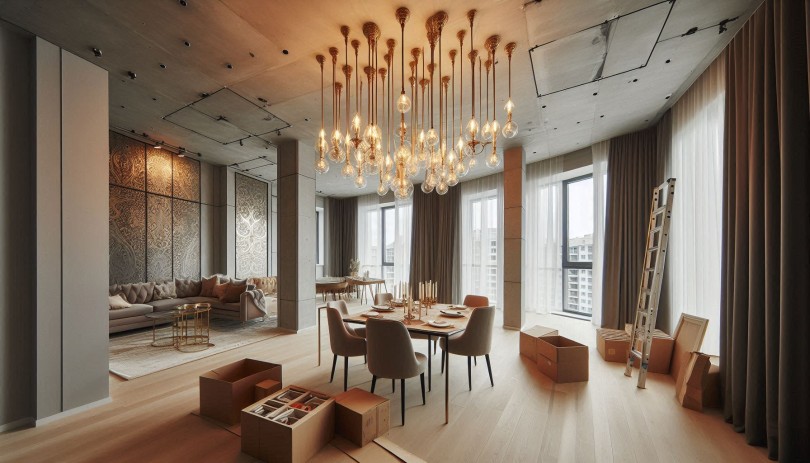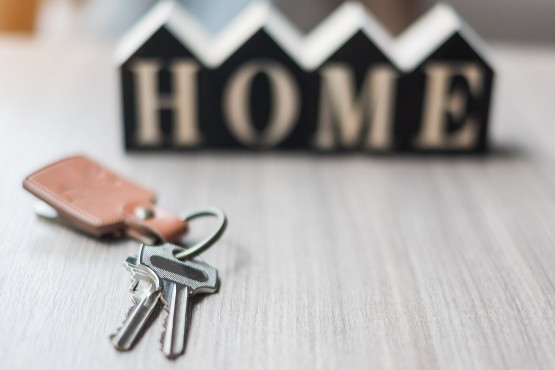Helpful information
16 August 2024
What is a developer's finishing touches?

What is a developer's finishing of an apartment?
Apartments with finishing from the developer can be purchased in different countries of the world. Moreover, buyers are offered a variety of options - from properties at the stage of the so-called rough repair to turnkey apartments.
Of course, the ideal option is to buy a property and move in immediately. And this can only be done if the final stage of repair work is completed - finishing.
In our article, we suggest that you figure out together what types of finishing there are, what is meant by finishing of an apartment in a new building, what are its pros and cons, and whether it is worth doing finishing repairs yourself.
What is a developer's finishing?
Finishing of an apartment in a new building is the final stage of any repair. It is started when the construction is completely finished, and all surfaces in the room are already leveled, the screed, plaster and putty are well dried, and utility lines are installed.
That is, during finishing works in apartments, ceilings and walls are painted, wallpaper is glued, floor coverings are laid - tiles, laminate, parquet, plumbing, sockets, entrance and interior doors are installed. An apartment completed for finishing is practically ready for moving in, that is, you can live in it: for this, the owner only needs to bring in furniture and household appliances.
Types of finishing of apartments in new buildings and differences between them
As such, there are no exact definitions of finishing options in new buildings and officially approved standards. That is, the list of options included in the housing sale package is determined by the developer himself. But depending on the stage of readiness, the following types of finishing works can be distinguished:
- Rough finishing
Minimum housing package from the developer, including basic finishing. As a rule, at this stage apartments are sold without finishing, with the only difference that some construction companies offer an empty box without interior partitions, floor screeds and communications wiring, but with double-glazed windows and an entrance door, while others additionally equip their properties with leveled walls, floor screeds, communications wiring and a higher-quality entrance door. The volume and types of work may vary significantly among different developers.
The advantages of purchasing such properties include the cost (as a rule, the price is 20-30% lower when compared to finished housing), the ability to make adjustments to the layout and control the repair process, eliminating defects along the way. But the wait for moving can drag on for a certain amount of time. In addition, the cost of finishing from the developer is often lower than the cost of repairs done independently.
- Pre-finishing or White Box
This is an intermediate - between rough and fine - option for finishing an apartment in a new building. The list of works that will be performed depends on the developer. The complete set and description of options are specified in the contract. As a rule, these are:
- floor, completely ready for laying the finishing coating;
leveled walls and ceilings with plaster; - routed communications (in some cases, plumbing installation is also provided);
- ready-made electrical system;
- double-glazed windows, entrance and interior doors.
White Box is a more popular finishing option among investors, despite the fact that such properties are more expensive than apartments without renovation. The thing is that preparing apartments with pre-finishing for occupancy takes a minimum of time.
- Fine finishing
As we have already mentioned, this type of real estate is chosen by buyers who want to move in immediately after the residential complex is put into operation. In this case, the choice of the developer is of particular importance. It is important to read in advance the reviews of owners who live in houses already built by the developer, evaluate the quality of the finishing and visit the showroom, where experienced construction companies demonstrate future finished apartment options.
- Turnkey finishing
This is a fine finish with additional equipment. Which options will be included depends entirely on the developer.
The difference between fine finishing and turnkey finishing
Fine finishing is a standard renovation of an object, most often intended for comfort-class housing. Turnkey finishing implies additional options, which is mainly typical for new buildings of business and premium class.
For example, some developers, when selling turnkey apartments, equip them with:
- kitchen furniture and a set;
- high-quality plumbing, household and climate control equipment;
- a basic set of furniture in the living room and bedrooms.
Other construction companies place greater emphasis on the use of elite-class finishing materials in the design of premises — package, marble, wood, etc. In new buildings of the premium segment, unique design projects of various styles are implemented.
That is, apartments with turnkey finishing are maximally ready for occupancy, have an individual interior design, but are also more expensive.
What is included in the final finishing of an apartment in a new building
What does the final finishing of an apartment from the developer include? As a rule, the package includes:
- Tiling work. Laying ceramic tiles and grouting are carried out at the final stage of repair, which allows tiling work to be classified as final finishing.
- Finishing putty. Some builders classify putty or plaster as rough work. Other experts classify it as a finishing stage of renovation, as the rooms in the apartment acquire their final form.
- Wall finishing. Depending on the chosen material, wall finishing involves painting, applying decorative plaster, wallpapering, or, for example, wood or stone cladding. Before decorating the walls, they must be leveled.
- Installing PVC and MDF panels. Wall panels are often used today instead of painting or wallpapering, and ceiling panels - instead of other ceiling coverings. In addition, with the help of such materials, all kinds of decorative niches and arches are created in apartments.
- Ceiling installation. Final work, which may include decorative painting of the ceiling, installation of suspended or tension structures.
- Floor installation. Different types of materials are also used for the floor. Basically, the floor covering is made of parquet, laminate, boards, ceramic tiles, linoleum. In addition to the floor itself, during the final finishing of the apartment, baseboards are installed, as well as underfloor heating with thermostats, if such an option is provided by the developer.
- Installation of entrance and interior doors, door frames. Entrance doors are usually steel, and interior doors are made of MDF for painting. Doors and door frames are installed after all finishing work in order not to damage adjacent surfaces and their finish.
- Installation of electrical equipment. Sockets, switches, lighting fixtures are installed.
- Installation of air conditioning equipment. Some developers only prepare and lay out cable routes for the installation of air conditioning equipment, which the owner buys after moving in. In some properties, air conditioners themselves are also installed. Often, developers prepare special places for the installation of external units of the air conditioning system - at the end of the building, so as not to spoil the appearance of the residential complex. Also, if provided for by the project, an individual gas boiler is installed in the apartment.
- Plumbing work. Plumbing fixtures must be installed in the kitchen and bathroom, including faucets, sinks and dryers in the bathroom.
- Arrangement of the kitchen and bathroom. In the kitchen, cabinet furniture with places for built-in household appliances, a countertop (often made of natural stone) is placed, and in the bathroom - cabinets, bedside tables.
In premium quality projects, leading developers equip apartments with additional options such as underfloor heating, a Smart Home system, double-glazed windows with enhanced heat and sound insulation, etc.
It is worth noting that, for example, in Turkey, all projects are handed over to the buyer only with finishing, prepared for occupancy, that is, apartments without renovation are not sold here, as, for example, in Russian-speaking countries. And this is one of the key advantages of buying Turkish real estate.
What materials do developers use for finishing
The materials used for finishing depend on where they are used, namely:
- Wallpaper, paint, and plasterboard are used for walls. The modern market offers a wide range of paints and wallpapers of various colors, textures, and raw materials used for production. Drywall is characterized by additional functional properties, such as heat and sound insulation.
- Parquet, laminate, and ceramic tiles are considered finishing materials for floors. These are durable, wear-resistant, and environmentally friendly materials.
- Drywall panels and stretch ceilings are used for finishing ceilings. These are finishing materials that, with proper care, will last for many years and remain resistant to mechanical impacts. With the help of plasterboard, various decorative elements are created, for example, stucco molding, niches for LED lighting.
Finishing materials are selected depending on the status of the residential complex, customer preferences, interior design.
What should be ready before final finishing
Preparation for final finishing or pre-finishing includes:
- Arrangement of interior partitions. At the stage of pre-finishing, all piers in the apartment are installed, the material for which can be, for example, aerated concrete or plasterboard.
- Plastering the walls under the finishing coating. That is, at this stage, the wall surfaces are well aligned. Only small errors are allowed - no more than 1-2 ml on horizontal surfaces. Also, the walls should not have cracks, peeling or other defects.
- Floor screed. White Box includes floor installation work. It is leveled using a screed, which must be checked for cracks and strength. Then you can start laying the flooring. In addition, all joints at the junction of the floor with the walls and partitions are processed.
- Ceiling preparation. Finishing the ceilings at the stage of preparation for final finishing involves leveling the surface and whitewashing them. That is, the ceiling is brought to a finished look, even if no further work is planned on installing a suspended or stretch ceiling.
- Installation of windows and window sills. After installing double-glazed windows, the absence of gaps between the walls and windows, the working condition of the window locks are checked.
- Wiring and installation of utility networks. In particular, we are talking about electrical wiring, plumbing, heating and sewerage systems. Communications must be laid out throughout the apartment.
Stages of finishing work
Finishing is the most important part of renovating an apartment in a new building. It must be carried out in stages and according to a previously developed design project. At the preparatory stage, specialists, understanding how the object will look after the completion of the repair work, calculate how many finishing materials will be needed, prepare an estimate and buy everything necessary.
Finishing of housing from the developer is carried out in strict sequence:
- At the initial stage, specialists recommend doing the final cladding of the ceiling in order to avoid further contamination of the walls and floor. If the ceiling is plastered and primed, then you can apply paint to it or install a tension structure.
- Next, tiles are laid in bathrooms, hallways, kitchens, that is, in rooms characterized by high humidity and frequent pollution. Other materials are also used for such purposes today, which are selected taking into account the described features. Before tiling, the walls and floor of the room are treated, an adhesive composition is applied, and then the tiles are laid according to the scheme. The fresh finish must dry completely, after which the seams are cleaned and grouted.
- The next stage of interior decoration is the installation of flooring. The choice of material is very important, due to the fact that this surface in the apartment will be subject to the greatest loads. If the concrete screed made at the stage of pre-finishing is not smooth enough, then an additional layer of a special composition is applied to the floor. As soon as the coating dries, laminate, parquet, marble, or cheaper materials, such as linoleum, are laid on the floor.
Important point: if the developer plans to install heated floors in the room, then the cable or pipes are laid before the laminate or parquet is laid.
- Wall cladding is the next stage of finishing in a new building. A variety of materials can be used here: from wallpaper and painting to decorative plaster, wood, natural and artificial stone.
- Installation of sockets, switches, wall and ceiling lamps, sconces. Since the utilities, including electrical wiring, have already been installed throughout the apartment, all that remains is to install lighting fixtures, check the correctness of the wire connections in the distribution boxes, and the presence of the necessary external equipment in the switchboard.
- Installation of interior doors, baseboards, door trims. The choice of materials and designs depends on the project provided by the developer or the individual wishes of the investor.
- The final step of finishing is plumbing work. If necessary, polypropylene pipes are installed, plumbing is installed.
Advantages of finishing
Without a doubt, real estate with finishing from the developer has a number of advantages, including: no need to make repairs, lower cost, compared to work done independently. And here everything is explained simply: developers closely cooperate with construction companies as wholesale buyers.
Among other advantages:
- Guarantees for internal repair work, valid for 2-3 years from the date of purchase of the property.
- You can immediately move in and live in new apartments.
- The owner does not need to waste time looking for a good construction team to do the repairs, as well as agree on the cost of the work and control all stages of execution.
Disadvantages of fine finishing
Among the disadvantages of fine finishing, it is worth highlighting:
- The use of low-quality materials and poorly executed work. In some cases, repairs from the developer will not be as high quality as if the repairs were done "for yourself". But in this case, everything depends on the developer - if you are dealing with a conscientious, experienced company, then the repair will be done "excellently" using high-quality, expensive materials.
- Difficulties in detecting any defects in rough and pre-rough finishes.
- If the owner is not satisfied with the layout of the apartment, then at the finishing stage any redevelopment work is fraught with additional costs of time and money.
- Difficulties in redoing the repair to suit your taste, since the owner will first have to get rid of the work already done, and only then carry out new ones.
Therefore, buying an apartment in a new building at an early stage of construction - one of the most popular options among investors, as it is possible to make radical adjustments to the repair work.
Why you shouldn't do the finishing renovation yourself
Is it worth doing the finishing in your apartment yourself? Most experts agree that you shouldn't, especially if you don't have the relevant skills and experience.
It is better for the finishing work to be done by the developer or specialized specialists in the following cases:
- if you don't have time to do the repair yourself;
- lack of experience, as this increases the risk of spoiling the materials and spending money on new purchases;
- if you have chosen expensive finishing materials, plumbing, electrical work, which require strict adherence to the technology of laying and installation.
Of course, finishing, compared to rough finishing, from an engineering point of view — not the most difficult stage. However, highly professional skills are required here to solve the entire volume of tasks. In addition, in order for the repair to be of high quality, knowledge and experience are necessary, otherwise the result obtained will not only not please you, but will also lead to additional waste of effort, time and money to redo everything again.
Read also



